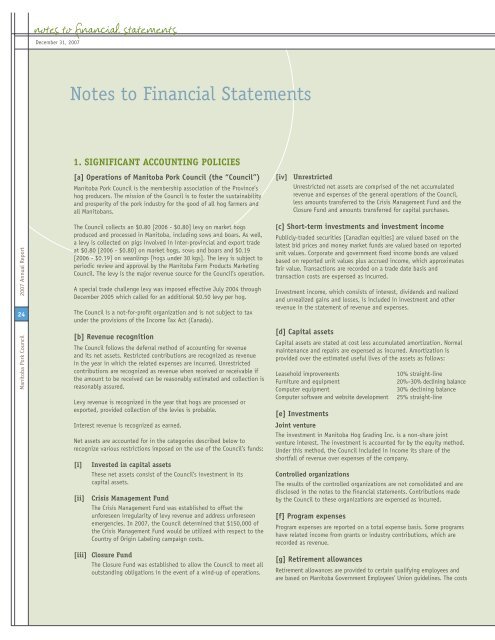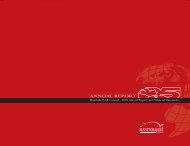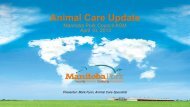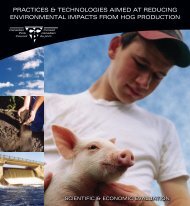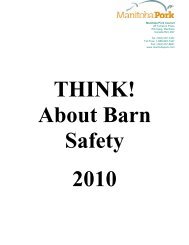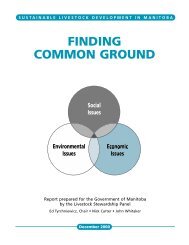2007 Annual Report - Manitoba Pork Council
2007 Annual Report - Manitoba Pork Council
2007 Annual Report - Manitoba Pork Council
- No tags were found...
Create successful ePaper yourself
Turn your PDF publications into a flip-book with our unique Google optimized e-Paper software.
notes to fi nancial statementsDecember 31, <strong>2007</strong>Notes to Financial Statements<strong>Manitoba</strong> <strong>Pork</strong> <strong>Council</strong> <strong>2007</strong> <strong>Annual</strong> <strong>Report</strong>241. SIGNIFICANT ACCOUNTING POLICIES[a] Operations of <strong>Manitoba</strong> <strong>Pork</strong> <strong>Council</strong> (the “<strong>Council</strong>”)<strong>Manitoba</strong> <strong>Pork</strong> <strong>Council</strong> is the membership association of the Province’shog producers. The mission of the <strong>Council</strong> is to foster the sustainabilityand prosperity of the pork industry for the good of all hog farmers andall <strong>Manitoba</strong>ns.The <strong>Council</strong> collects an $0.80 [2006 - $0.80] levy on market hogsproduced and processed in <strong>Manitoba</strong>, including sows and boars. As well,a levy is collected on pigs involved in inter-provincial and export tradeat $0.80 [2006 - $0.80] on market hogs, sows and boars and $0.19[2006 - $0.19] on weanlings [hogs under 30 kgs]. The levy is subject toperiodic review and approval by the <strong>Manitoba</strong> Farm Products Marketing<strong>Council</strong>. The levy is the major revenue source for the <strong>Council</strong>’s operation.A special trade challenge levy was imposed effective July 2004 throughDecember 2005 which called for an additional $0.50 levy per hog.The <strong>Council</strong> is a not-for-profit organization and is not subject to taxunder the provisions of the Income Tax Act (Canada).[b] Revenue recognitionThe <strong>Council</strong> follows the deferral method of accounting for revenueand its net assets. Restricted contributions are recognized as revenuein the year in which the related expenses are incurred. Unrestrictedcontributions are recognized as revenue when received or receivable ifthe amount to be received can be reasonably estimated and collection isreasonably assured.Levy revenue is recognized in the year that hogs are processed orexported, provided collection of the levies is probable.Interest revenue is recognized as earned.Net assets are accounted for in the categories described below torecognize various restrictions imposed on the use of the <strong>Council</strong>’s funds:[i]Invested in capital assetsThese net assets consist of the <strong>Council</strong>’s investment in itscapital assets.[ii] Crisis Management FundThe Crisis Management Fund was established to offset theunforeseen irregularity of levy revenue and address unforeseenemergencies. In <strong>2007</strong>, the <strong>Council</strong> determined that $150,000 ofthe Crisis Management Fund would be utilized with respect to theCountry of Origin Labeling campaign costs.[iii] Closure FundThe Closure Fund was established to allow the <strong>Council</strong> to meet alloutstanding obligations in the event of a wind-up of operations.[iv] UnrestrictedUnrestricted net assets are comprised of the net accumulatedrevenue and expenses of the general operations of the <strong>Council</strong>,less amounts transferred to the Crisis Management Fund and theClosure Fund and amounts transferred for capital purchases.[c] Short-term investments and investment incomePublicly-traded securities [Canadian equities] are valued based on thelatest bid prices and money market funds are valued based on reportedunit values. Corporate and government fixed income bonds are valuedbased on reported unit values plus accrued income, which approximatesfair value. Transactions are recorded on a trade date basis andtransaction costs are expensed as incurred.Investment income, which consists of interest, dividends and realizedand unrealized gains and losses, is included in investment and otherrevenue in the statement of revenue and expenses.[d] Capital assetsCapital assets are stated at cost less accumulated amortization. Normalmaintenance and repairs are expensed as incurred. Amortization isprovided over the estimated useful lives of the assets as follows:Leasehold improvementsFurniture and equipmentComputer equipmentComputer software and website development10% straight-line20%–30% declining balance30% declining balance25% straight-line[e] InvestmentsJoint ventureThe investment in <strong>Manitoba</strong> Hog Grading Inc. is a non-share jointventure interest. The investment is accounted for by the equity method.Under this method, the <strong>Council</strong> included in income its share of theshortfall of revenue over expenses of the company.Controlled organizationsThe results of the controlled organizations are not consolidated and aredisclosed in the notes to the financial statements. Contributions madeby the <strong>Council</strong> to these organizations are expensed as incurred.[f] Program expensesProgram expenses are reported on a total expense basis. Some programshave related income from grants or industry contributions, which arerecorded as revenue.[g] Retirement allowancesRetirement allowances are provided to certain qualifying employees andare based on <strong>Manitoba</strong> Government Employees’ Union guidelines. The costs


